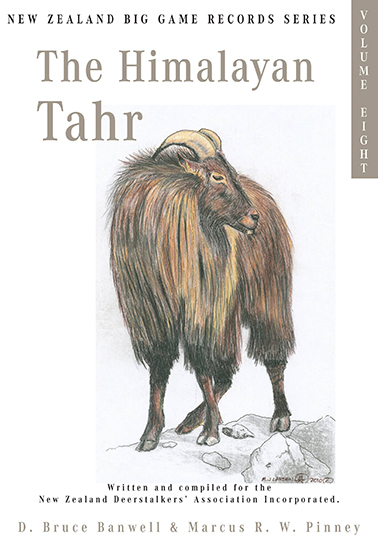Book Reviews » The Himalayan Tahr
 D.Bruce Banwell & Marcus R. W. Pinney
D.Bruce Banwell & Marcus R. W. Pinney
The Halcyon Press
RRP $40
Reviewed by Daryl Crimp
Volume eight in the popular New Zealand Big Game Records series and epitaph for the well respected Bruce Banwell, The Himalayan Tahr has been eagerly awaited by collectors of the series and alpine hunters alike. From the outset, the book, through its title, puts to bed the controversy of the spelling of tahr – not thar. It then continues in the authoritative style that has become trademark Banwell. The only divergence from previous titles in the series is the co-authorship with renowned South Westland guide and accomplished alpine hunter, Marcus Pinney. When Bruce was diagnosed with an inoperable brain tumour, he chose Marcus to complete his work, a task he achieved admirably and professionally. Ironically, or perhaps serendipitously, both Bruce and Marcus hunted their first tahr on Mesopotamia Station in the Rangitata River. This tenuous connection gives the book a subtle synergy: two generations of hunter who share similar respect, ideals, thoughts and criticisms regarding tahr, their value, management and status. Divided into two parts, The Himalayan Tahr becomes an extensive reference guide for tahr hunters, nature lovers, and biologists, and forms a valuable historical record of tahr in New Zealand. However, it is far from dry reading. Part one deals with the history, origins, and nature of tahr internationally, including the laying to rest of the tahr argument, something that was obviously a professional if not academic thorn in Banwell’s side for may years. It is fascinating reading that should engender even greater respect for this magnificent game animal amongst hunters and the wider, discerning public. Part two focuses on tahr in New Zealand, from a historical perspective covering establishment, distribution, and range, the commercial recovery era, and thoughts on helicopter assisted ‘hunting’, through to hunting techniques and tips. A good portion of this section is given over to the value of tahr as a trophy animal, a look at significant trophies, and an index of records. Well supported by colour and B&W photographs, both historical and contemporary, The Himalayan Tahr is a well-produced, comprehensive book that is richer for Pinney’s involvement. The only disappointing weakness is the cover design – the illustration fails to do justice to the book or this magnificent alpine animal. A highly recommended read and deserved of a place in every hunting or outdoor enthusiast’s library.

